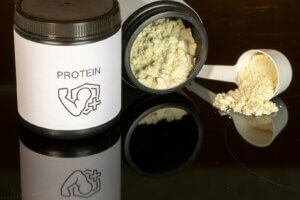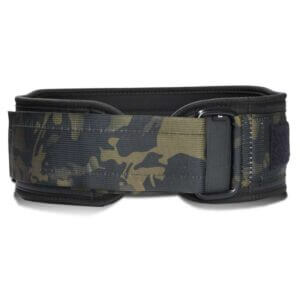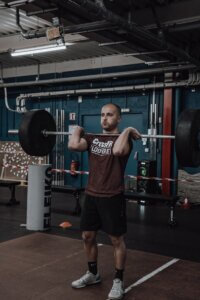How to Push Press

Introduction:
The push press is a dynamic and powerful exercise that is fundamental in CrossFit training and strength conditioning. This exercise combines elements of strength, speed, and coordination, making it an excellent addition to any fitness regimen. Aimed at those with basic knowledge of CrossFit training, the push press helps develop upper body strength and explosive power. In this article, we will delve into the mechanics of the push press, provide step-by-step instructions, discuss necessary equipment, offer scaling options, highlight common mistakes, and explore the benefits and muscle groups targeted by this versatile movement.
Steps in the Push Press movement
- Starting Position:
- Stand with your feet shoulder-width apart.
- Hold a barbell at your shoulders, with your elbows slightly in front of the bar, your grip just outside your shoulders, and your core engaged.
- Dip:
- Perform a small dip by bending your knees slightly and lowering your body a few inches, keeping your torso upright and core tight.
- Drive:
- Explosively extend your hips and knees, driving the barbell overhead.
- Press:
- As you extend, press the barbell straight up, using the momentum generated by your lower body.
- Lockout:
- Fully extend your arms at the top, with the barbell directly overhead, and your body in a straight line.
- Return:
- Lower the barbell back to your shoulders with control, preparing for the next repetition.
What Equipment is needed
Selecting the right equipment is essential for performing the push press safely and effectively. A quality barbell is fundamental; look for one with a comfortable grip diameter and appropriate knurling to ensure a secure hold. Pairing the barbell with suitable weight plates allows for adjustable resistance to match your strength levels. Using collars to secure the plates is crucial to prevent them from shifting during the dynamic movement. Weightlifting shoes can provide a stable base, offering a firm sole and slight heel lift to enhance your posture and power during the lift. Additionally, utilizing wrist wraps can offer support to the wrists, reducing strain and promoting proper alignment. Incorporating chalk can improve grip, especially during longer sessions where perspiration may be a factor. Investing in high-quality equipment not only enhances performance but also contributes to safety and longevity in your training.
Check out the Equipment subsite for more tools, tips, and inspiration.
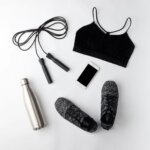
Shop Fitness gear now on Amazon
See Amazons extensive range of workout gear here. (Affiliate Link)
Scaling Options:
To gradually build strength and proficiency, consider the following scaling options:
- Dumbbell Push Press: Use dumbbells instead of a barbell for a variation that allows for greater range of motion and can be easier to handle for beginners.
- Push Press with Kettlebells: Use kettlebells instead of a barbell for a variation that allows for greater range of motion and can be easier to handle for beginners.
- Reduced Weight: Start with a lighter weight to master the technique before gradually increasing the load.
Common Mistakes to Avoid:
- Incorrect Dip: Avoid leaning forward or letting your knees collapse inward during the dip. Keep your torso upright and knees tracking over your toes.
- Pressing Too Early: Ensure you fully extend your hips and knees before pressing the barbell overhead. Use the power from your legs to drive the bar up.
- Not Locking Out: Fully extend your arms and lock out the elbows at the top of the movement to complete the rep and engage all necessary muscles.
- Poor Core Engagement: Maintain a strong core throughout the movement to prevent excessive arching of the back and ensure stability.
Benefits of the Movement:
- Increased Upper Body Strength: Targets the shoulders, triceps, and upper chest, promoting muscle growth and strength.
- Explosive Power: Enhances explosive power and speed, translating to improved performance in various athletic activities.
- Core Stability: Engages the core muscles, improving overall stability and balance.
- Functional Fitness: Mimics real-life movements and enhances overall functional fitness, aiding in daily activities and sports performance.
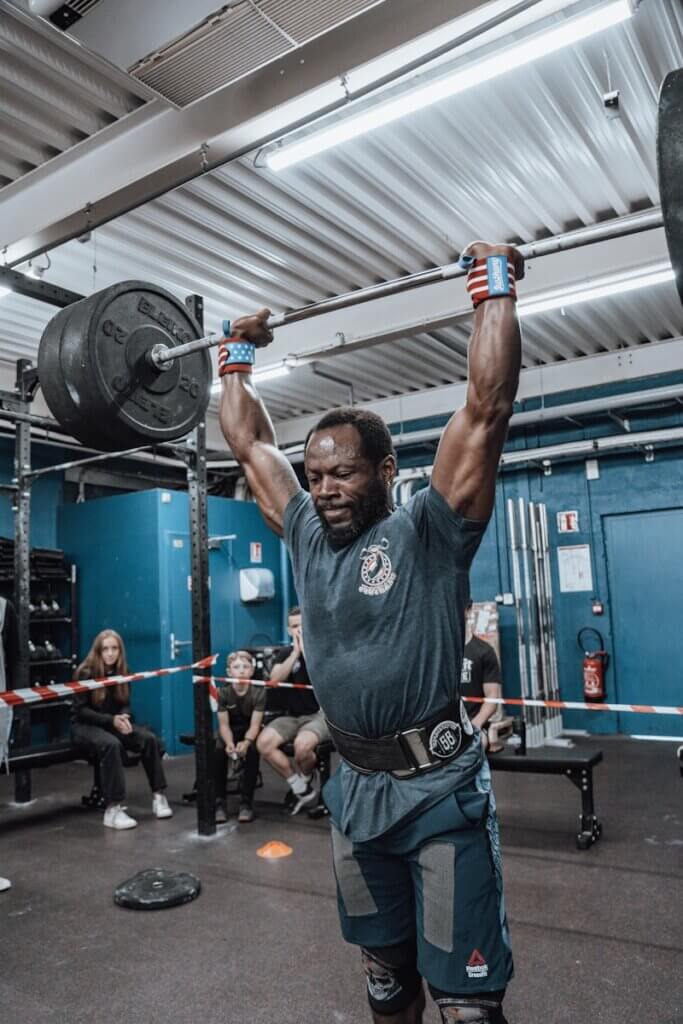
Which Muscles Are Worked:
During this exercise, the following muscle groups are engaged:
- Primary Muscles: Deltoids, triceps, upper pectorals.
- Secondary Muscles: Core muscles, including abdominals and obliques, quadriceps, glutes, and lower back.
Alternative Similar Movements:
If you’re seeking variation or targeting specific muscle groups, consider incorporating these alternative exercises:
- Strict Press: A similar movement without the use of leg drive, focusing solely on upper body strength.
- Push Jerk: Involves a more dynamic dip and drive, with a re-bending of the knees to catch the bar overhead.
- Thruster: Combines a front squat with an overhead press, providing a full-body workout.
- Overhead Squat: Incorporates a squat while holding the barbell overhead, requiring greater mobility and stability.

Shop Fitness gear now on Amazon
See Amazons extensive range of workout gear here. (Affiliate Link)
Safety Precautions and Injury Prevention
Prioritizing safety is crucial when performing the push press, especially given the involvement of heavy weights and dynamic movements. Before initiating the exercise, ensure a thorough warm-up to prepare the muscles and joints for the demands of the movement. This can include light cardio and dynamic stretching, focusing on the shoulders, hips, and knees. It’s essential to maintain proper form throughout the exercise to prevent injuries. This includes keeping the core engaged to support the lower back, ensuring the knees track over the toes during the dip, and avoiding excessive arching of the back during the press. Listening to your body is vital; if you experience pain or discomfort, stop the exercise and consult a fitness professional. Additionally, consider having a spotter present, especially when lifting heavier weights, to assist if needed and ensure safety. Regularly inspecting your equipment for wear and tear can also prevent accidents caused by faulty gear. By adhering to these safety precautions, you can minimize the risk of injury and perform the push press effectively.
Programming the Push Press into Your Workout Routine
Integrating the push press into your workout regimen can significantly enhance upper body strength and power. Typically, the push press is incorporated into strength training sessions, often following compound movements like squats or deadlifts. Depending on your fitness goals, you can adjust the sets and repetitions. For strength development, consider performing 3-5 sets of 4-6 repetitions with heavier weights. For muscular endurance, 3 sets of 8-12 repetitions with moderate weights may be more appropriate. It’s important to allow adequate rest between sets, usually 2-3 minutes, to ensure optimal performance and recovery. Additionally, varying the tempo of the movement can provide different stimuli; for instance, a slower eccentric phase can increase time under tension and promote muscle growth. Incorporating the push press into a well-rounded program that includes pulling movements, lower body exercises, and core work will promote balanced development and prevent muscular imbalances. Always consider your individual goals and consult with a fitness professional to tailor the programming to your specific needs.
Mobility and Flexibility Considerations
Adequate mobility and flexibility are vital for executing the push press with proper form and preventing injuries. Focus on enhancing shoulder mobility to allow for a full range of motion during the press. Incorporate exercises such as shoulder dislocates with a resistance band or dowel to improve flexibility. Hip and ankle mobility also play a significant role, especially during the dip and drive phases of the movement. Performing deep squats and ankle dorsiflexion stretches can aid in achieving the necessary range of motion. Regularly practicing thoracic spine mobility drills, like foam rolling and cat-cow stretches, can enhance upper back flexibility, contributing to better overhead positioning. Integrating a comprehensive mobility routine into your training regimen will facilitate smoother movement patterns, improve performance, and reduce the risk of compensatory injuries. Consistency in these practices is key, and over time, you’ll notice improvements in your push press execution and overall functional movement.
Progressions and Variations to Enhance the Push Press
To continue making progress and prevent plateaus, it’s beneficial to incorporate variations and progressions of the push press into your training. One effective progression is the push jerk, which involves a more pronounced dip and drive, allowing for heavier loads and increased power development. Another variation is the single-arm dumbbell push press, which challenges unilateral strength and stability, highlighting and addressing any imbalances between sides. The behind-the-neck push press is an advanced variation that can enhance shoulder mobility and strength but should be approached with caution and proper guidance. Additionally, incorporating tempo variations, such as pausing at the dip or slowing down the eccentric phase, can increase time under tension and promote muscle growth. Implementing these progressions and variations not only keeps your training engaging but also ensures comprehensive development of strength, power, and coordination. As always, prioritize proper form and consider consulting with a fitness professional when introducing new movements into your routine.

Shop Fitness gear now on Amazon
See Amazons extensive range of workout gear here. (Affiliate Link)
Q&A for Push Press
How can I properly do a push press?
To properly do a push press, start with the barbell at shoulder level, perform a small dip by bending your knees, then explosively extend your hips and knees to drive the bar overhead. Ensure you lock out your arms fully at the top before lowering the bar back to your shoulders with control.
What are the cues for push press?
Key cues for the push press include keeping your torso upright during the dip, using your legs to generate power, driving your elbows up as you press, and locking out your arms at the top of the movement.
How do I push an overhead press?
To push an overhead press, ensure your grip is just outside shoulder-width, engage your core, and press the bar directly overhead while keeping your body stable. Lock out your arms at the top and maintain a straight line from your wrists to your hips.
How strong should your push press be?
Your push press strength can vary depending on your training level, but a good benchmark is to aim for 75-85% of your body weight. Regular practice and incremental weight increases will help you build strength over time.
Is push press better than military press?
The push press is not necessarily better than the military press; it depends on your goals. The push press involves more lower body engagement, making it great for power development, while the military press focuses solely on upper body strength.
Do push presses build muscle?
Yes, push presses build muscle, especially in the shoulders, triceps, and upper chest. The explosive movement also engages the core and lower body, contributing to overall muscle development.
Why is military press so hard for me?
The military press can be challenging due to its strict form requirement and the need for significant shoulder and core strength. Practicing regularly, improving shoulder mobility, and building overall upper body strength can help.
Is Push Press or push jerk harder?
The push jerk is generally harder than the push press because it requires more technique and coordination, involving a re-bending of the knees to catch the bar overhead. Both movements are valuable, but the push jerk has a steeper learning curve.
Does Push Press build traps?
Yes, the push press helps build traps due to the overhead pressing movement, which engages the trapezius muscles. The traps are activated to stabilize and lift the weight overhead.
Is push press easier than strict press?
The push press is generally easier than the strict press because it uses the lower body to generate momentum, reducing the load on the shoulders and arms. The strict press relies solely on upper body strength.
Can you jerk in Strongman?
Yes, the jerk is a common movement in Strongman competitions, especially in events like the log press or axle press. It allows athletes to lift heavier weights by utilizing the lower body and technique.
Is it harder to do pushups fast or slow?
Doing pushups slowly is generally harder because it increases the time under tension, making your muscles work longer and harder. Fast pushups can be more challenging for endurance and cardiovascular conditioning.
How can I make push press easier?
To make the push press easier, start with a lighter weight to focus on technique, use dumbbells or kettlebells for more manageable variations, or incorporate resistance bands to assist with the movement. Gradually increase the weight as you build strength and confidence.
Is push press good for shoulders?
Yes, the push press is excellent for shoulders as it targets the deltoids, triceps, and upper chest. It also promotes overall upper body strength and stability, making it a beneficial exercise for shoulder development.
Conclusion:
Incorporating the push press into your training regimen can yield significant benefits in terms of strength, power, and overall fitness. With dedication and proper form, you can master this dynamic movement and enhance your CrossFit performance. So grab a barbell, focus on technique, and start pushing your limits with the push press!

Shop Fitness gear now on Amazon
See Amazons extensive range of workout gear here. (Affiliate Link)

🏋️ Written by: Mike Kerr
Mike is the founder of Strengthguides.com and a certified CrossFit Level 1 Trainer (CF-L1) and certified Kettlebell Instructor with over 10 years of experience in functional fitness. He specializes in developing programs that maximize performance without sacrificing mobility. Mike Kerr is passionate about making complex training methodologies comprehensible and safe for everyone.


